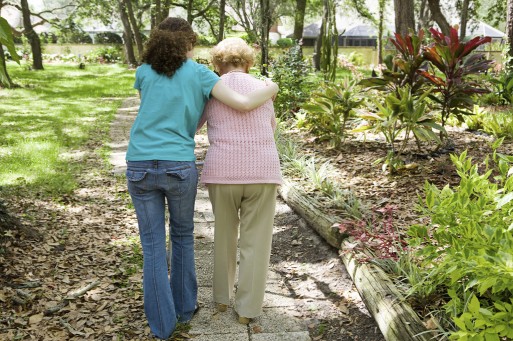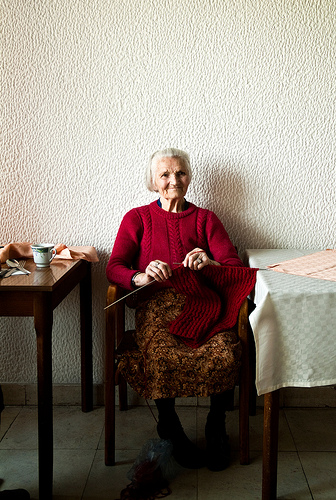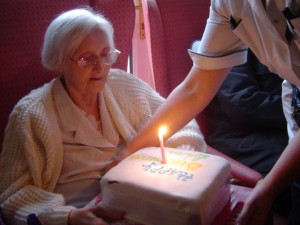Today SevenPonds is speaking with Julie Groves, owner of the occupational therapy organization Therapy In Your Home. Julie has been working in the field of home care since 1980, including experience in working in hospitals and rehabilitation facilities.
Kimberly: How did you get into occupational therapy?
Julie: In college, I realized that I couldn’t decide between psychology, physical therapy and physiology, and my mother figured out that occupational therapy might be what I was interested in based on my interest in doing things, adaption to time and how clients adapt to their situation and how that has to do with living well.
Kimberly: Do you work with a lot of clients near the end of their lives?
Julie: Occupational therapy covers three main specialties: pediatrics, physical disabilities and mental health. It covers the entire lifespan from both the physical and psychological perspective.
Kimberly: What are some common services that you prescribe to clients?
Julie: That depends on which specialty that you are addressing. For the geriatric population at home, you’re looking at how to help them stay home. If it’s for a caregiver, you are looking at how to adapt the environment to make it safer, how to change the task so that they can still stand up and walk to the bathroom, to get their evening medication and do everything they need to do standing up. Maybe we would help them see that they can still do some of those things in the early afternoon when they still have energy, so they can get to bed at night without being so exhausted. Or a person may have just been given a walker by the physical therapist, but we would help them learn how to get their milk out of the refrigerator and carry it over to the table.
There’s a focus on how their outlook is psychologically in understanding and learning about the end-of-life experience with these limitations, with their disability. There’s a focus on function; there’s a focus on helping people change their habits well. A big focus is safe drivers, and sometimes that means helping families figure out: “Is this person safe and how are we going to help them understand that they shouldn’t be driving anymore?”

Credit: Flickr
Kimberly: Can you give us more details on specific areas of life that you try to improve with your services?
Julie: On a basic level, there are persons in the home or at the hospital that focus on helping them move safely: getting in-and-out of a car, up-and-down stairs, in-and-out of a bed, in-and-out of a chair. You can imagine how many people need instruction on sitting down and standing up all day long without injuring themselves. So you’re not only teaching the patient, you’re also teaching the caregivers.
Helping people change their habits so that they stay active longer is also important. It’s about learning how to integrate it and get that into their day so that they don’t stop doing that after they get out of therapy. So, from a psychological standpoint, for a well population, you’re getting questions like: “How do I accept help?”, “How do I ask for help well?”, “How do I set boundaries and say ‘no’?” and “How do I offer help well?”. My particular practice is a combination of being paid by medication, insurance and private pay. In my particular business, we are doing outpatient therapy to provide help to people in their own homes.
Kimberly: How does occupational therapy differ from home caregiving?
Julie: The caregiver is doing their job on their own on an ongoing basis. They’re not skilled providers. They’ve had some training as a caregiver, but not the skills in neurological function, cognitive function, vision, psychological response to a disability. The caregiver is not able to bill insurance and Medicare for their services because it’s not a skilled service.

Credit: Flickr
Kimberly: Do you work with home nurses as well or do you take the place of that role?
Julie: Insurance or Medicare has two buckets. One pays for their hospitalization, their nursing home and their home health agency, which is nursing, social workers and therapy going out to the home. When you graduate from that, you use your second reimbursement, which is your outpatient therapy, which pays for your doctor’s appointments and your therapy in the clinic. We are the outpatient therapy, but we’re providing it in the home. We don’t provide nursing, but the one under home-health does provide nursing. So we’re working right alongside nurses as part of the team.
Kimberly: Can you take us through the process of how you would individualize the care plan for the client?
Julie: We listen. Our company in particular is very patient-centered. We hear what their goals are; we listen to the caregivers’ goals; we look at the environment and how adaptable it is; we find out what they’re hearing from their family and what their family needs. We’re really the eyes and ears for the physicians and for the case manager who sent us out. We only make the changes that the client is willing to do. And that’s a very delicate balance. That’s what our skill is: figuring out how much change can occur, how motivated they are and how much they understand.
Kimberly: Do you have a lot of meetings with your client to boil down a plan?
Julie: It’s an ongoing process. You start with an overview and get started right then with making some changes based on their own priorities. Then you see how they respond and what their learning style is and make plans for the next visit on what you’ll address then.
Kimberly: Can you give us an idea of how you work with geriatric doctors to fulfill care plans?
Julie: Sometimes the doctor says, “This person isn’t functioning well; see what you can do to help.” Sometimes the doctor gives us more specific details like, “this person has a bad shoulder; See what you can do to help.” So it depends on what needs the doctor sees.
Usually we go back to the doctor and tell them what the problem is, what is causing it and our recommendations. Then we get an okay from the doctor for what we are going to do and we continue to keep them informed. We help the client advocate for themselves a lot as well to make sure that they can tell their needs to the doctors.
Kimberly: Do you have any stories for how occupational therapy has positively affected your clients’ lives?
Julie: For instance, a daughter in New York will call us when she is worried about her mother. She’ll say that she is worried about what her mom is doing and if she needs to be doing more, and we can report with the daughter that her mom really does need more help, or we can report back that she is taking steps to do well, like calling her friend every night and going out regularly.
Another situation would be a son that is hurting his back every night getting his mother out of bed. He may not realize that he doesn’t need to use all of his physical strength to lift his mom up and down. Mom can help some too, which is better for mom and better for his back.
Maybe a wife and a patient are at odds with each other over a new diagnosis of Parkinson’s, where one doesn’t feel that they are helping enough and the other isn’t feeling that they are listening to their needs. We can help them work through this to make Parkinson’s the main problem rather than their conflict with each other.

Credit: Wikipedia
Kimberly: Are there any common questions you get when you meet with people for the first time?
Julie: The questions people always ask are: “How much does it pay?”; “Will there be any jobs?”; “How is it different than a physical trainer?”; “How is it different from nursing?”. The answer to how it’s different from nursing is that nursing is more about taking care of the person and OT (occupational therapy) is more about helping people change. That’s not so true anymore, but there used to be quite a difference in what would go into being an OT versus what goes into nursing. Now the answer to these questions determines what area of nursing or OT you will go in to.
Kimberly: Do you spend a lot of time with patients in their homes?
Julie: Yes. A visit tends to be an hour and it’s not just talking about things, it’s actually doing things and watching the patient and the caregiver. If you’re working with kids, it’s also helping them do the tasks that improve posture and sensitivity and coordination.
Kimberly: Are there services or plans that you more commonly offer to clients at the end of their lives.
Julie: Most hospices don’t have therapists on staff. Some hospices around here will pay for us to come in and provide therapy to their clients. For specific instruction, like teaching a person how to get out of bed more easily, teaching the families what an appropriate level of exercise is for that person, or helping them figure out whether it’s still appropriate for them to be going to the bathroom by themselves or whether they should be supervised. There are very specific instructions that it just takes about one visit to clarify to the family what needs to be done.
The questions we usually ask are “Is it safe?”; “Do you know what to do when something happens on a bad day or when there is a decline in function?”; “How can you help the person in hospice to feel safe and comfortable?”.
Kimberly: Do you also offer cognitive exercises that can help with your clients?

Credit: Wikipedia
Julie: Anxiety is such a common problem for the young and the old. Almost routinely, we get feedback about how they are responding to frustration, fear, having a caregiver, NOT having a caregiver. We’re responding to this feedback and teaching them to remember to breathe, to take time out for themselves, to use mental hygiene techniques, just like they use physical hygiene techniques.
Julie’s 4 Mental Hygiene Tips
1. Be aware of what those feelings are. Frustration, loneliness, fear. Stay with the turmoil and think about it.
2. Notice how it affects your body.
3. Do you have to frame the question this way, or is there a different perspective?
4. Know that your physical help is dependent on your mental health, and your mental health is dependent on your physical health. Get enough sleep, drink enough water and move.
Kimberly: So this is more analytical than meditative?
Julie: Yes. Meditation will guide them to this way, and it works for those who already believe. But sometimes you have to take people to that point to get them to believe and change their lives. That’s why occupational therapists work on those two aspects, rather than a physical therapist, who may work on physical exercise. And 90% of my calls are asking for a physical therapist, where an OT may be more appropriate to help them start doing the exercises that they may already have gotten from other therapists and doctors.
Kimberly: Do you have any advice for family members who are taking care of a loved one that can benefit from occupational therapy?
Julie: First, ask yourself if you even have time or the bandwidth to have one more person come in and tell you what to do. You may be overwhelmed, but that also may mean that you need to have someone come in and help you figure out what things you need to cut back on and what things you can do.
Kimberly: Thank you!
Julie: Thank you.
Read Part One of this interview here!

 What is Occupational Therapy? An Interview with Julie Groves, Part One
What is Occupational Therapy? An Interview with Julie Groves, Part One



 John Mulaney’s “Funeral Planning” on Netflix: No Real Plan
John Mulaney’s “Funeral Planning” on Netflix: No Real Plan

 Composting Bodies Is Now Legal in a Dozen States
Composting Bodies Is Now Legal in a Dozen States














